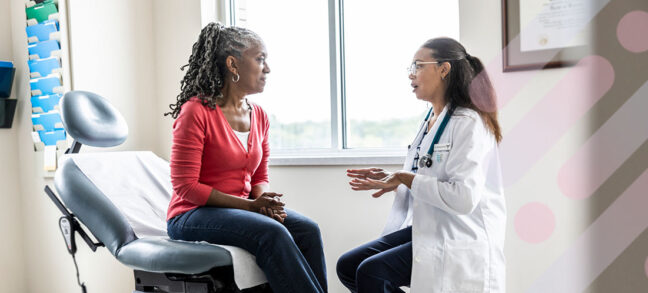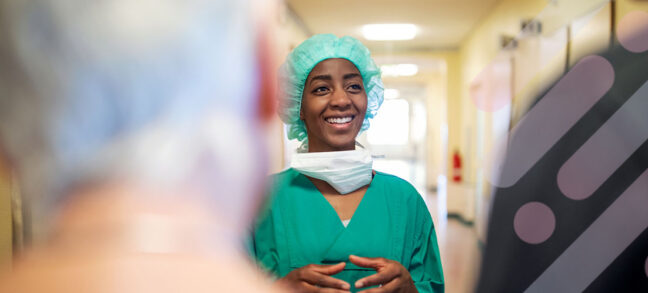With over 20 years of experience as a plastic surgeon, Dr. Kamran Khoobehi has distinguished himself with his aesthetic and reconstructive results – including performing an eyelid reattachment surgery. To save the sight of a young woman injured by a dog bite, Khoobehi operated for six hours under magnification to reconnect the delicate skin, connective tissue, and network of tiny blood vessels of the eyelid.
Today, Dr. Khoobehi applies his expertise in microsurgery to breast reconstructive surgery with Resensation. By offering Resensation to women undergoing breast reconstruction, Dr. Khoobehi uses a nerve graft to potentially return sensation to reconstructed breasts after mastectomy.
“With reconstruction, we can help women look great aesthetically,” said Dr. Khoobehi. “With Resensation, we can make reconstruction even better, and offer a more complete reconstruction.”
What do women need to know about their breast reconstruction choices?
Women should know that implants are not the only option for reconstruction post mastectomy.
There is a type of breast reconstruction that uses a patient’s own tissue, called an autologous or free flap reconstruction, to reconstruct the breasts. During a DIEP (deep inferior epigastric perforator) free flap procedure, tissue is transferred from the lower abdomen (skin along with fatty tissue) to the chest to reconstruct a breast.
In some cases, a patient may not have enough fatty tissue for flap reconstruction and for those women we have to use implants. But for patients who are able to use their own tissue, we are able to recreate breasts that are more similar to what they’ve lost. And now with Resensation, we also have the opportunity to potentially restore sensation to the patient’s reconstructed breasts no matter which reconstruction option they choose.

Why did you decide to make breast reconstruction after mastectomy a focus of your practice?
Breast reconstruction is a very challenging yet rewarding procedure. A surgeon will use all of the skills mastered, from plastic surgery principles to advanced microsurgery techniques. We are rewarded by combining our experience with advanced technology to help our patients feel whole again after a mastectomy.
In the past, a mastectomy patient had to wear prosthesis, and they had a scar running through their chest. Each time they took a shower they were reminded of the pain they went through.
I recently had a DIEP flap reconstruction patient who went to see a new OB-GYN, and the doctor didn’t believe she had reconstruction because her scars were unnoticeable, and her breasts looked so normal.
By being able to offer the potential of sensation, we can really take breast reconstruction to the next level. Sensation was the part that was missing. Resensation is an advancement in breast reconstruction – offering women shape, size, look, and now potentially sensation.
Do women ever discuss being bothered by the lack of sensation after breast reconstruction?
Breast reconstruction patients are usually happy to have breasts for their physical appearance. But some would bring up that they didn’t have sensation. When their breasts touched something, they didn’t know it.
We didn’t talk about it much though, because we didn’t have much to offer them. We had to accept that the aesthetic results were the best we could do. Once the nerve allograft became available, it became more feasible to reconnect the nerves and possibly restore sensation.
How do women react when you offer the option of Resensation with their breast reconstruction?
We tell patients the surgery is going to take us a little bit more time to reconnect the nerve. Across the board, all of them say, ‘Yes. Please do that.’ It’s a little more work for the surgeon, but it’s always worth the extra effort to provide patients with the most advanced technique. With Resensation, I can provide my patients with a more complete reconstruction – not only cosmetically, but also potentially feeling and sensation-wise.
What advice do you have for women if they’ve been diagnosed with breast cancer and are considering a mastectomy?
Try not to panic. Before you go through with a mastectomy, talk to a qualified, board-certified plastic surgeon who offers both implant and autologous free flap breast reconstruction. If you go to a surgeon who only performs implant reconstruction, you may not be made aware of other possible solutions. I think it’s important to go to a plastic surgeon, or a group, that also offers both implant and free flap reconstruction. This provides you with the opportunity to decide what option is right for you.
In our practice, we offer both because some patients are candidates for autologous free flap reconstruction, while some patients either don’t have enough tissue, or have other medical problems or a lifestyle that may make implants a better choice for them. There’s more than just a one-size-fits-all approach to breast reconstruction. You need to look at the whole picture.
I would recommend that women have more than one consultation before making a decision. Do your homework. Ask surgeons what kind of procedures they do. Ask other patients who have gone through breast cancer surgeries about their experience and get as much information as possible.
When you’re discussing the mastectomy with your breast surgeon and plastic surgeon, ask a lot of questions.
Here are some questions I suggest asking:
- What types of breast reconstruction options do you offer?
- What is autologous free flap reconstruction?
- Do you offer breast neurotization with Resensation?
- Where are you going to make the incision?
- Where will the scar be?
- Will I need to come back at a later date for the lift?
When you’re preparing to do a breast reconstruction with Resensation, how do you work with the breast surgeon who will do the mastectomy?
The intercostal nerves can be used for potentially returning sensation to the breast – the second and third intercostal nerves are typically used, although for some patients the fourth intercostal nerve may be a better alternative. We work with the breast surgeon to make sure they preserve enough of the nerve so we can work with it.
We also work with the breast surgeon on where to place the incision so that it will heal the best, so the scars will be as hidden as possible and women will not have to be reminded every day of what they’ve gone through. Some surgeons are resistant to change. But breast surgeons who are in tune with their patients are as interested as we are in taking the mastectomy and reconstruction to the next level.
About Kamran Khoobehi, MD
Dr. Kamran Khoobehi is a board-certified plastic surgeon in New Orleans, Louisiana. He is committed to ensuring that his patients are fully comfortable before, during and after their plastic surgery, from the process of deciding on a procedure to the completion of their post-operative recovery. Dr. Khoobehi provides patients with his home phone number so they can reach him if they need advice, instruction or reassurance.
Dr. Khoobehi is a clinical professor and plastic and reconstructive surgeon at Louisiana State University Health Sciences Center in New Orleans. Dr. Khoobehi offers DIEP flap breast reconstruction and performs a large number of secondary breast surgeries for women who have had suboptimal outcomes from breast augmentation performed elsewhere. Dr. Khoobehi is a member of the American Society of Aesthetic Plastic Surgery, the American College of Surgeons and the American Board of Plastic Surgery. He has authored numerous research studies and has been featured in medical journals for his work in plastic and reconstructive surgery.
For more information or to contact Dr. Khoobehi, visit his website.
________________________
Dr. Khoobehi received no compensation from Axogen Corporation for his time in connection with this interview.
Resensation Blog

How does mastectomy impact the nerves in the breast?
One sometimes overlooked aspect of mastectomy is its impact on nerves. Read what happens to nerves during mastectomy and explore…
Read More
What happens during implant breast reconstruction with Resensation®?
By repairing sensory nerves, Resensation® enables you to potentially regain sensation to your chest. Read how this procedure works during…
Read More
how resensation® helped Leanna feel secure in her family’s future
With Resensation®, Leanna can be there to watch her kids grow up—without losing the feeling of being whole.
Read More
sensory retraining: what is it, and how can it help me after resensation®?
Sensory retraining is a series of exercises designed to help you reconnect with your body after breast reconstruction with Resensation®.
Read More